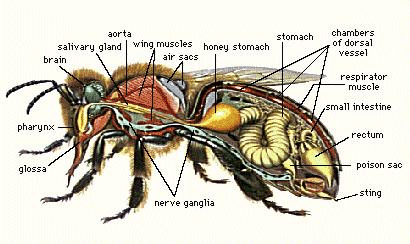Information Page
 |
The Anatomy of a Honey Bee |
Why do people get stung by bees?
Contrary to widespread opinion, bees do not go round looking for people to sting. The most common bee in U.K. is the introduced European honeybee (Apis mellifera). The female worker bee is the one you will see around your home and garden, she is mostly looking for nectar to take home to be made into honey; in the process she pollinates your fruit, vegetables and flowers. Without bees, most garden and farm produce would not produce fruit. Bees do a lot more for us than supply us with honey and beeswax. During the early spring bees may go hunting for a new home for a swarm to move into, or in hot weather looking for some water for the hive's cooling system. In any case, they are definitely not looking for people to sting! Bees only sting in defence of themselves or their hive. They sting if you walk on them in bare feet when they are gathering water from your lawn, they sometimes get caught in your hair and think they are under attack, and they sting if you sit on them or swipe at them, but they do not attack without provocation. A major reason for this attitude is that stinging kills them. The barbs on their sting lodge in the flesh and when the bee tries to get away she rips out the stinger and attached venom sacs and dies soon after. To avoid being stung simply leave the bees alone, resist the urge to swipe at them if they land on you, they are only looking for water. Do not hang around the hives, especially near the entrance.
What do I do if I am stung by a bee?
1. Walk, don't run, away from where you were when stung, the now dying bee which stung you and the detached sting are giving off pheromones which enrage bees, so any other bees in the immediate area will sting you too! They believe there must have been good reason for their mate to sting you, they don't know it was only because you stepped on her or swiped at her. The reason for not running is that sudden movements alarm bees and may trigger an attack.
.....................................................................................................................................................
2. Remove the sting. Do not pull it out by gripping it with your fingers as the venom sacs are still attached, and you will squeeze in a lot more venom than was injected in the first place. Slide the back of a knife, a comb or if necessary a fingernail along the skin to 'scrape' it out. Do this while you are walking away from where you were stung as the detached sting continues to pump venom for some time after it is detached from the bee; the sooner you remove it the less venom will be injected. The sting will probably cause a bit of pain for 10 minutes or so, and may be itchy for a day or two. .....................................................................................................................................................
After a few years of beekeeping, It seems that we become desensitised to bee venom, and have a reduced reaction. People allergic to bee venom can become seriously ill and even die from a bee sting. It is suggested to seek immediate medical treatment. Some highly sensitised people carry a hypodermic syringe containing an appropriate dose of adrenalin.

 Home
Page.
Home
Page.